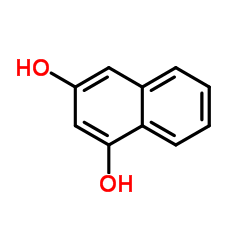Naphthoresorcinol

Naphthoresorcinol structure
|
Common Name | Naphthoresorcinol | ||
|---|---|---|---|---|
| CAS Number | 132-86-5 | Molecular Weight | 160.169 | |
| Density | 1.3±0.1 g/cm3 | Boiling Point | 361.5±9.0 °C at 760 mmHg | |
| Molecular Formula | C10H8O2 | Melting Point | 123-125 °C(lit.) | |
| MSDS | Chinese USA | Flash Point | 185.5±13.3 °C | |
| Symbol |

GHS07 |
Signal Word | Warning | |
|
Selective antiproliferative activity of hydroxynaphthyl-beta-D-xylosides.
J. Med. Chem. 49 , 1932-8, (2006) The antiproliferative activity of the 14 isomeric monoxylosylated dihydroxynaphthalenes has been tested in vitro toward normal HFL-1 and 3T3 A31 cells as well as transformed T24 and 3T3 SV40 cells. The antiproliferative effect toward HFL-1 cells was correlate... |
|
|
Mutagenicity of products formed by ozonation of naphthoresorcinol in aqueous solutions.
Mutat. Res. 189(3) , 217-22, (1987) The mutagenicity of products formed by ozonation of naphthoresorcinol in aqueous solution was assayed with Salmonella typhimurium strains TA97, TA98, TA100, TA102 and TA104 in the presence and absence of S9 mix from phenobarbital- and 5,6-benzoflavone-induced... |
|
|
Effector-repressor interactions, binding of a single effector molecule to the operator-bound TtgR homodimer mediates derepression.
J. Biol. Chem. 281(11) , 7102-9, (2006) The RND family transporter TtgABC and its cognate repressor TtgR from Pseudomonas putida DOT-T1E were both shown to possess multidrug recognition properties. Structurally unrelated molecules such as chloramphenicol, butyl paraben, 1,3-dihydroxynaphthalene, an... |
|
|
Dynamic synthesis of a macrocycle containing a porphyrin and an electron donor.
Chem. Commun. (Camb.) (14) , 1842-4, (2005) New macrocycles incorporating a porphyrin and a [small pi] electron-rich aromatic were prepared from a dynamic disulfide library. The outcome could be influenced by use of templates. |
|
|
Determination of glycolaldehyde in the presence of hydroxypyruvate and tartronate semialdehyde.
Anal. Biochem. 106(2) , 342-3, (1980)
|
|
|
Mutagenicity on chlorination of products formed by ozonation of naphthoresorcinol in water.
Mutat. Res. 226(3) , 151-5, (1989) The mutagenicity of products formed by chlorination after ozonation of naphthoresorcinol in aqueous solution was assayed with Salmonella typhimurium strains TA98 and TA100 in the presence and absence of S9 mix from phenobarbital- and 5,6-benzoflavone-induced ... |
|
|
Evaluation of 5-(4-nitrophenyl)-2,4-pentadien-1-al (NPPD) as a tracer for shadowing pursuits.
J. Forensic Sci. 49(3) , 517-22, (2004) The chemical compound 5-(4-nitrophenyl)-2,4-pentadien-1-al (NPPD), called "spy dust," was used in the Soviet Union as a shadowing pursuit, the act of following someone secretly, for investigating the activities of diplomatic personnel. It is also useful for c... |
|
|
In silico identification and biochemical evaluation of novel inhibitors of NRH:quinone oxidoreductase 2 (NQO2).
Bioorg. Med. Chem. Lett. 20 , 7331-6, (2010) The NCI chemical database has been screened using in silico docking to identify novel inhibitors of NRH:quinone oxidoreductase 2 (NQO2). Compounds identified from the screen exhibit a diverse range of scaffolds and inhibitory potencies are generally in the mi... |